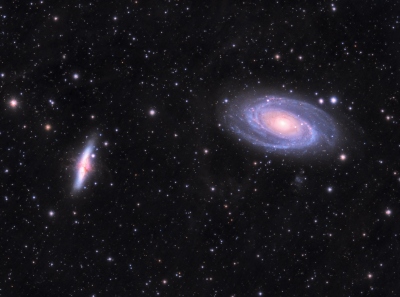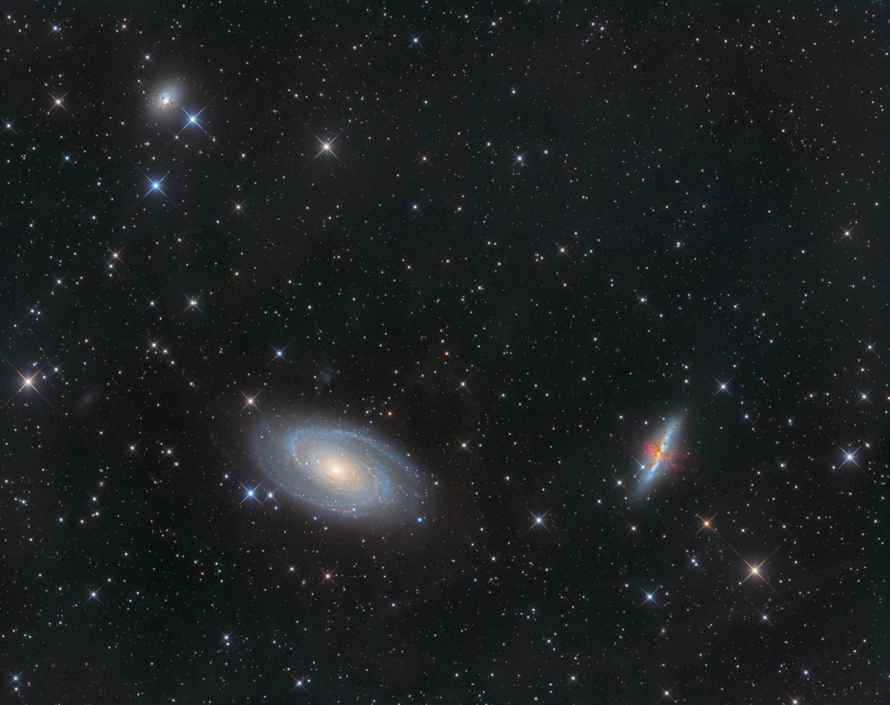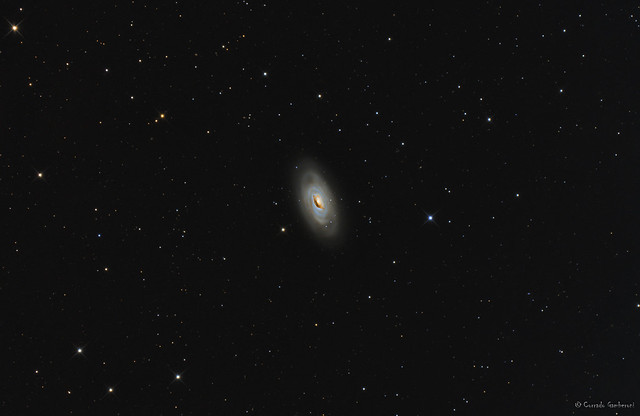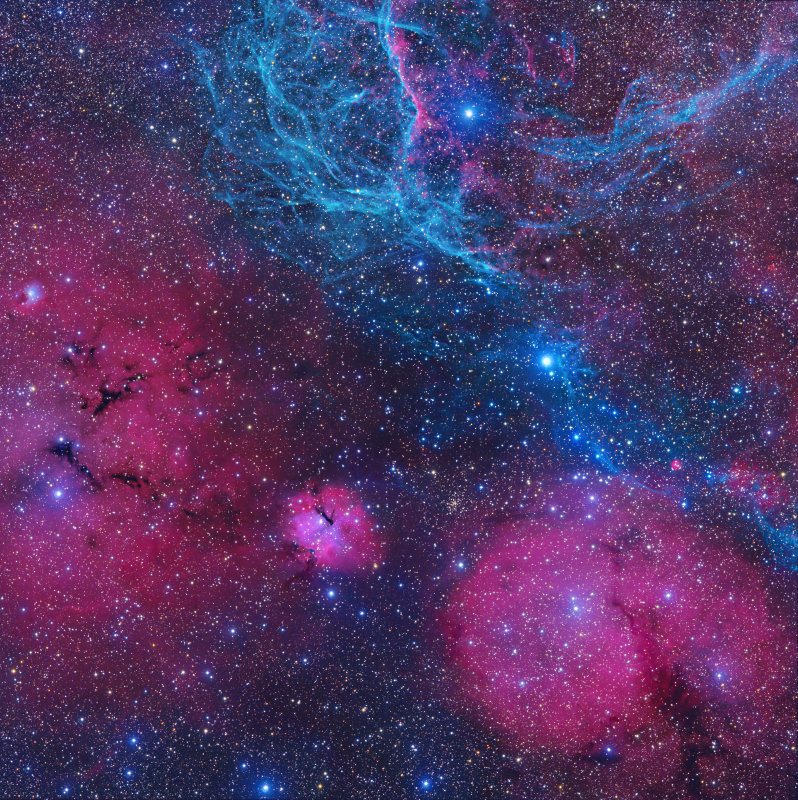Page 3 of 5
Re: Submissions: 2020 March
Posted: Tue Mar 17, 2020 7:50 pm
by barretosmed
Unique moments
BEST DETAILS:
https://www.astrobin.com/full/shdrf2/0/?nc=user
Equipment:
Canon 6D
Rokinon 14mm 2.4
TC Astro Duo-Narrowband Filter
Single frame 30 "
Iso 1600
PROCESSING:
Adobe Photoshop.
Place and date:
Munhoz - MG - Brazil
06/30/2019
Copyright: Fernando Oliveira de Menezes
Email:
Barretosmed@hotmail.com
Re: Submissions: 2020 March
Posted: Tue Mar 17, 2020 11:28 pm
by markh@tds.net
IC 2220 - Toby Jug Nebula
Copyright: Mark Hanson
Located towards the constellation of Carina, IC 2220 is a fairly rare example of a yellow reflection nebula. It was given the popular name of the Toby Jug Nebula in 1979 after its appearance in colour photographs taken by David Malin at the Anglo-Australian Observatory.
The central illuminating star it surrounds is the variable red giant V341 Carinae. Studies done by professional astronomers in the past attributed its formation to either mass loss or being ejected by an unseen companion. There is often difficulty in ascertaining the three dimensional structure of a nebula based on our two dimensional view of it. IC 2220 is likely to be both bipolar and biconical.
Reflection nebulae surrounding red giant stars are scarce and the very few examples that are known happen to be a case of ambient interstellar matter in the surrounding region being illuminated. Despite the Toby Jug Nebula lying in a region of interstellar dust, it is unique that not only is it illuminated by a red giant but it has also been produced by it as well via mass loss. The visibility of the nebula is produced by dust grains reflecting the light of the star and it contains a mixture of elements with silicon dioxide being the most likely responsible for the reflection.
Studies by professional astronomers in the past postulated that V341 Carinae was a former member of the open cluster NGC 2516 in the past. This association was based on both sharing similar distances. However in subsequent decades, better quality and more accurate astrometry data from the Hipparcos satellite showed that V341 Carinae had a much closer distance than NGC 2516 of 1200 light years while NGC 2516 has a distance of 1300 light years.
However in the 21st century, more detailed observations are not exclusively reserved for the professional realm of astronomy. Through the proliferation of the internet and other technologies, it is possible for amateur astronomers to own or operate remote observatories. In fact, this image is the product of a remote observatory in Chile being operared by the image author in America.
One such amateur astrophotographer called Josep Drudis who owns a remote observatory in Australia (along with a certain Don Goldman), with the assistance of his daughter Anna, serendipitously took hydrogen alpha exposures for IC 2220 in 2018 for the sake of curiosity and exploration. What was uncovered could not have been predicted, the presence of multiple overlapping arc shaped nebulosities and bubbles. Visually these are represented by the red waves of hydrogen gas visible in this deep image.
Taking into account the well known history of V341 Carinae involving mass loss, these likely represent multiple episodes of mass loss prior to the event that generated the yellow reflection nebula. This is further supported by the separation of the various parts of the whole nebula. There is an absence of ionized hydrogen alpha emission coinciding with the reflection nebula as this is younger and more recent and probably not containing any hydrogen. Since V341 Carinae is known to be a red giant star with an age of 50 million years, it is not unreasonable to assume that the larger and older hydrogen bubbles represent the outer layers of the star that have been ejected in the past. As of March 2020, these enigmatic structures haven't been studied by professional astronomers yet.
Description by Sakib Rasool
Data from El Sauce, Chile 17” Planewave CDK
RGB - 340 Min each, HA - 600-min
Full Resolution image here:
https://www.hansonastronomy.com/ic2220toby-jug
Thank you,
Mark Hanson
Re: Submissions: 2020 March
Posted: Wed Mar 18, 2020 12:38 pm
by Tamas Abraham
Saturn, Jupiter, Mars and the Moon
http://www.vadakcsillaga.hu/tajkep/ejsz ... 00318.html
Copyright: Tamas Abraham
Thanks for watching,
Tamas
Re: Submissions: 2020 March
Posted: Thu Mar 19, 2020 8:08 am
by vanamonde81
Inverse Startrails (a.k.a Starlink goes to Big Dipper)
Copyright: György Soponyai
On Tuesday evening, a "massive" transit of ~50 Starlink satellites was visible in front of Big Dipper. I'm afraid this is the future of wide-field nightscape photography.. :-/
 2020.03.17. Mogyoród, Hungary
2020.03.17. Mogyoród, Hungary
Canon EOS 5D Mark II + Samyang EF 24/1.4
40x30 sec, F2.8, ISO 400
Re: Submissions: 2020 March
Posted: Fri Mar 20, 2020 2:24 am
by Sergio
NGC 1965/66 in the LMC
Discovered by William Herschel in 1835, NGC 1965 is one of the many objects we can image independently within the Large Magellanic Cloud. The nebulosity present a circular bubbled shape formed by massive amount of gas and dust. A regular imager from the southern hemisphere can spend the whole season imaging fantastic objects from our outstanding neighbour galaxy.
Taken from Buenos Aires Argentina, suburban skies.
More information and image with labels can be found in below link
http://www.baskies.com.ar/PHOTOS/NGC%201965%20LRGB.htm
Cheers for now!
Sergio
Re: Submissions: 2020 March
Posted: Fri Mar 20, 2020 8:06 am
by Tamas Abraham
Equinox conjunction
http://www.vadakcsillaga.hu/tajkep/ejsz ... 00320.html
Copyright: Tamas Abraham
Thanks for watching,
Tamas
Re: Submissions: 2020 March
Posted: Fri Mar 20, 2020 11:18 am
by David Wills
It's amazing what a 5.5-inch telescope can capture from 33 million light-years away considering one light-year is about 5.88 trillion miles (9.5 trillion km). This was quite a difficult image to process as I found it challenging to reveal the detail within the galaxy without overdoing it.
Messier 95, also known as M95 or NGC 3351, is a barred spiral galaxy located about 33 million light-years away in the zodiac constellation Leo. It was discovered by Pierre Méchain in 1781, and cataloged by fellow French astronomer Charles Messier four days later. It has around 40 billion stars.
Captured by David Wills at PixelSkies,Castillejar, Spain
www.pixelskiesastro.com
Lum 48x600Secs
Red 51x300Secs
Green 59x300Secs
Blue 54x300Secs
13 hours 40 mins in total.
Equipment used:
Telescope: Tec 140 F7
Camera: Xpress Trius SX-694 Pro Mono Cooled to -10C
Image Scale: 0.95
Guiding: OAG
Filters: Astronomik LRGB Ha
Mount: iOptron CEM60 "Standard" GOTO Centre Balanced Equatorial Mount
Image Acquisition: Voyager
Observatory control: Lunatico Dragonfly
Stacking and Calibrating: Pixinsight, Photoshop
Processing: Pixinsight 1.8
 https://images.squarespace-cdn.com/cont ... rmat=1500w
https://images.squarespace-cdn.com/cont ... rmat=1500w
Re: Submissions: 2020 March
Posted: Fri Mar 20, 2020 2:29 pm
by Giacomo
M-31 Andromeda
Shooting performed by the astronomical park of Brallo di Pregola By Giacomo Zacchi
LRGB- 180' 30' 30' 30'
Maunt Mathis 500, CCD Sbig ST 8300 optics FSQ-106ED
Copyright Giacomo Zacchi
zacchigiacomo@gmail.com
Full resolution:
http://www.astrobrallo.com/gallery/var/ ... 1584713440
Venus - March 19th
Posted: Fri Mar 20, 2020 3:04 pm
by Efrain Morales
Venus on March 19th, 22:36ut. ( LX200ACF 305mm OTA, CGE Mount, ASI290mm Cmos, TeleVue 3x Barlows, IR,G, UV filters. )
Re: Submissions: 2020 March
Posted: Fri Mar 20, 2020 6:24 pm
by John2y92

M81 & M82 Galaxies of Ursa Major
Taken from my backyard. Total integration time was nearly 18 hours and it is HaLRGB combination.
Explore Scientific 102/714 + 0.8x reducer
ZWO ASI1600MM Pro with ZWO filters
iOptron CEM60
Processed in Pixinsight and Photoshop
Re: Submissions: 2020 March
Posted: Sat Mar 21, 2020 6:26 am
by leemr
NGC 2359 aka Thor's Helmet
This is just over 31hrs of narrowband data (H and O) captured from my backyard in QLD, Australia.
Copyright: Lee Borsboom.
Email:
lee.borsboom@gmail.com
Full res can be found here:
https://www.astrobin.com/full/d7oal9/D/?nc=leemr&real=
Re: Submissions: 2020 March
Posted: Sun Mar 22, 2020 3:25 pm
by felopaul
NGC 1788 , The cosmic bat
HaRGB :
full size :
http://www.cielboreal.com/galerie/photo111f.jpg
done with CDK20, Moravian G4-16000 on Paramount ME2 near Actacama Desert in Chile, El Sauce Observatory
http://www.cielaustral.com
Copyright: Team CielAustral with J.C CANONNE, N.OUTTERS, P. BERNHARD, D. CHAPLAIN & L. BOURGON
Re: Submissions: 2020 March
Posted: Mon Mar 23, 2020 11:12 am
by PatrickWinkler
M81 M82 NGC3077
Posted: Mon Mar 23, 2020 11:58 am
by litobrit
Hello,
17 hours of LRGB Ha with my ASA10.
The full is here:
https://cdn.astrobin.com/thumbs/f2z2THr ... jz_rdB.jpg
I hope you enjoy !
Re: Submissions: 2020 March
Posted: Mon Mar 23, 2020 12:10 pm
by felopaul
Total reprocessing 2020 :
IC 434
LHaRHaGB :
full size :
http://www.cielboreal.com/galerie/photo93f.jpg
NGC 253
LRHaGB :
full size :
http://www.cielboreal.com/galerie/photo87f.jpg
M16
SHORGB :
full size :
http://www.cielboreal.com/galerie/photo88f.jpg
NGC 3324
SHORGB :
full size :
http://www.cielboreal.com/galerie/photo80f.jpg
done with CDK20, Moravian G4-16000 on Paramount ME2 near Actacama Desert in Chile, El Sauce Observatory
http://www.cielaustral.com
Copyright: Team CielAustral with J.C CANONNE, N.OUTTERS, P. BERNHARD, D. CHAPLAIN & L. BOURGON
Re: Submissions: 2020 March
Posted: Mon Mar 23, 2020 7:44 pm
by astrocam
Re: Submissions: 2020 March
Posted: Mon Mar 23, 2020 7:45 pm
by astrocam
Re: Submissions: 2020 March
Posted: Tue Mar 24, 2020 1:29 am
by mdieterich
Running Chicken Nebula
www.mdieterichphoto.com
Copyright: Matt Dieterich
Here is a view of an emission nebula in the constellation Centaurus known as the Running Chicken Nebula. The bright glowing red is hydrogen gas that is emitting red wavelengths of light after absorbing energy from nearby starlight. I used a PlaneWave CDK24 telescope and L-600 mount to capture 8 hours of images through LRGB filters from ObsTech in Chile. I processed the images with PixInsight and Photoshop.
Re: Submissions: 2020 March
Posted: Tue Mar 24, 2020 4:12 am
by mr1337
M83 - Southern Pinwheel Galaxy
Tried to emphasize the dark dust lanes in this image, my first southern hemisphere galaxy! Images were taken from 2/26/2020 through 3/18/2020 in El Sauce, Chile.
L: 18x600 sec
R: 12x600 sec
G: 14x600 sec
B: 12x600 sec
Ha: 19x1800 sec
Total Integration time: 18.8 hrs
Full details at
https://www.astrobin.com/full/bn2v4b/0/
Re: Submissions: 2020 March
Posted: Tue Mar 24, 2020 7:36 pm
by astromazzo
1 Hour of exposition (90x40sec) with a Marcon RC 20" at F/4.5 + CDS-5D & Idas NGS Filter.
Emerald green coma with very thin tail, a little longer.
Dr Paolo Candy -
www.hesnet.net/candy
Ci.A.O. Cimini Astronomical Observatory
Re: Submissions: 2020 March
Posted: Tue Mar 24, 2020 10:31 pm
by Sergio
Delta 1 & 2 Chamaeleontis
Near the South Celestial Pole lies the small constellation of Chamaeleon, with some nice gems to offer. In this case a lovely pair of stars with colour contrast known by Delta 1 & 2 Chamaeleontis. Delta 1 is the dimmer of the two main stars with a yellow to red colour. Delta 2 is the brightest one with a pale blue colour. Both are very good visual targets for binoculars and telescopes. They do not show the contrast of Albireo. These two are not related to each other. They are just placed in perspective.
More information at
www.baskies.com.ar
Best Regards
Sergio
Vela Supernova Remnant and Gum Nebulae
Posted: Wed Mar 25, 2020 6:55 am
by strongmanmike
Down under we have had a terrible last few months, with copious smoke over our summer, from devastating fires, keeping us locked up inside for days at a time, over months and that I am sure you all read and heard about, that made it all but impossible to image.... and now, like everyone else around the globe...a new dark isolated Covid19 period to endure.
Luckily, the skies cooperated recently to finally allow me to get out to my observatory for 4 nights over a couple of weeks
Using the FSQ106EDX4 and FLI PL16803 I manged to capture this scene of what, strangely, reminds me of a coral reef.
Vela SNR and Gum Nebulae:
https://www.flickr.com/photos/strongman ... ateposted/ (click on image and have a pan around)
A shining light of beauty in otherwise pretty dark times...

Hope you like it...
Mike
Re: Submissions: 2020 March
Posted: Wed Mar 25, 2020 5:53 pm
by Paulee97
Comet C/2019 Y4 ATLAS hiding in dust
Copyright: Pavel Váňa
I tried to capture this beautiful encounter but unfortunately 3 hours of shooting was not enough for these dust clouds, so this picture is a bit noisy. But I hope you will like it. Many years ago people was scared of comets because they thought that comets cause disastres. I hope that novadays nobody will blame this beautiful comet for coronavirus situation.
Place: Jezeřany-Maršovice, Czech Republic
Link to better resolution:
https://flic.kr/p/2iHE44F
Re: Submissions: 2020 March
Posted: Wed Mar 25, 2020 10:21 pm
by Jean-Baptiste Auroux
Rosette Nebula Starless version
Full version :
https://cdn.astrobin.com/thumbs/n9B6plo ... zXV3LN.jpg
Rosette Nebula in SHO, "starless" version.
Setup : Newton ASA500mm - ASA DDM85 mount - FLI ProLine16803 - Astrodon filters - Chilescope remote facility
SHO - Processing : Pixinsight - PS - Starnet++
Total integration : 9h20
Copyright: Jean-Baptiste Auroux
https://millenniumphoton.com/
https://www.astrobin.com/users/Jean-Baptiste_Paris/
Re: Submissions: 2020 March
Posted: Wed Mar 25, 2020 11:38 pm
by StefanMuckenhuber
M106 from my backyard
Exposure time: 5 h
8" f/4.5 newton
ZWO ASI071
Skywatcher EQ6-R















